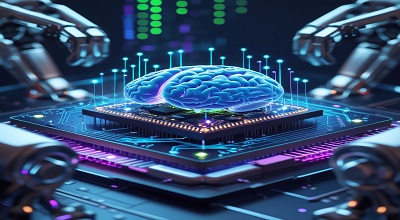Neuromorphic Computing
Neuromorphic Computing: Neuromorphic computing is a revolutionary approach to AI hardware, inspired by the human brain’s structure and functionality. Unlike traditional silicon-based processors, neuromorphic chips use artificial neurons and synapses to process information in a highly efficient, parallel manner.
Why Is It Important?
- Enables low-power, high-speed AI processing
- Mimics human cognition for smarter machines
- Potential to transform robotics, healthcare, and IoT
History and Evolution of Neuromorphic Chips
The concept dates back to the 1980s, with Carver Mead pioneering the idea of brain-like circuits. Over the decades, advancements in nanotechnology, material science, and AI algorithms have accelerated progress.
Key Milestones:
- 1980s: Mead’s foundational work
- 2014: IBM’s TrueNorth chip (1 million neurons)
- 2021: Intel’s Loihi 2 with improved learning capabilities
How Neuromorphic Chips Work?
These chips rely on Spiking Neural Networks (SNNs), which communicate via electrical spikes (similar to biological neurons). Memristors (memory resistors) play a crucial role in mimicking synaptic plasticity.
4. Latest Breakthroughs (2024-2025)
- Intel Loihi 2: Faster, scalable, and supports new AI models
- BrainScaleS-2 (Europe): Combines analog and digital processing
- Startups like BrainChip & SynSense: Commercializing neuromorphic AI
Advantages Over Traditional Computing
- 1000x more energy-efficient than GPUs
- Real-time learning without heavy data transfers
- Better at pattern recognition & sensory processing
Challenges & Limitations
- Fabrication difficulties (nanoscale precision required)
- Lack of standardized software frameworks
- Ethical debates on AI autonomy
Real-World Applications
- Robotics: More adaptive and responsive machines
- Healthcare: Prosthetics with natural sensory feedback
- Cybersecurity: Faster threat detection
Future Predictions
- 2025-2030: Wider adoption in edge AI devices
- 2030+: Potential merger with quantum computing
- Long-term: Machines with near-human cognitive abilities?
FAQs
Q1: How is neuromorphic computing different from quantum computing?
A: Neuromorphic computing mimics the brain’s structure, while quantum computing leverages quantum mechanics for ultra-fast calculations.
Q2: Can neuromorphic chips replace GPUs in AI?
A: Not entirely—they excel in specific tasks like real-time learning but may coexist with GPUs for general AI workloads.
Q3: What are the biggest challenges in neuromorphic engineering?
A: Hardware scalability, software compatibility, and high R&D costs.
Q4: Are there any consumer devices using neuromorphic chips yet?
A: Limited deployments in research labs, but expect commercial IoT and robotics soon.
Q5: Will neuromorphic AI lead to conscious machines?
A: Unlikely in the near future—consciousness remains a philosophical debate.
Conclusion
Neuromorphic computing is set to redefine AI, making machines smarter and more energy-efficient. Stay updated with the latest tech trends at ZoomDoors.com!
Free Here: Soulmask Game

